![]()
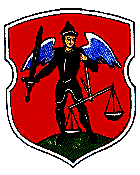
Navahradak (Novogrudok in Russian, Nowogrodek in Polish) is the center of the Navahradak district, situated in the Hrodna region, 162 km East of Hrodna, 22 km from the station Navajel'nia on the railway line Lida-Baranavicy.
Population: 31,200 (1995)
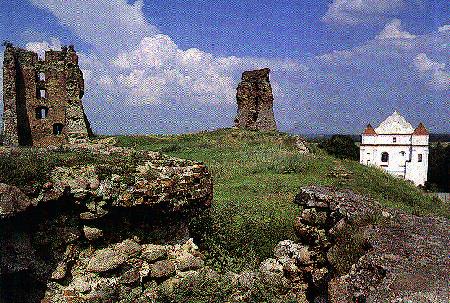
The historical "Novoharodak" was founded by the Kievan prince Jaroslav Mudry (the Wise) in 1044, after his campaign against the Baltic tribe Litva, which lived in the upper reaches of the river Nioman. At that time the Slavic inhabitants of the area (the tribes Dryhavicy and Kryvicy) were dominant among "islands" of Baltic tribes, including the heathen tribe Litva. The foundation of a Slavic city played therefore an important part in the further development of the area.
In the 11th - beginning of the 12th century the city was a bone of contention between Polacak and Kiev, a fact illustrated by the campaigns undertaken
by the Prince of Polacak Usiaslau the Magician in 1066 and by Gleb, Prince of Minsk, in
1119. In the second half of the 12th century Novaharodak became ruled by the princes of
Galic-Valyn' (a territory today in North-Western Ukraine). 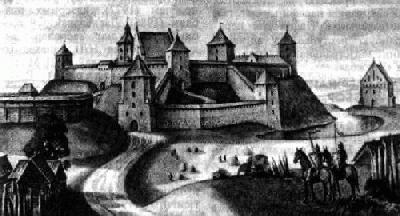
In the 1240s Novaharodak started fighting for its independence and tried to unite neighboring territories under its leadership. By that time Novaharodak and its surroundings had - for a number of reasons - already reached a high level of social and economic development. Agriculture was highly developed, due to fertile soils, which were not to be found in the Dzvina region (Polacak region), for example. The population density was also higher than in other regions of Belarus' and this promoted the development of craft and trade. We can say that Novaharodak had a sophisticated feudal system and sharp class division. The economic and cultural level was exceptionally high. This is confirmed by archaeological findings.
See also our separate page on Navahradak castle
The advantages of Navahradak's favorable geographical location made themselves felt
in the mid-13th century, when other Eastern Slavic territories were plagued by two great
miseries: the Eastern and Southern principalities were seized and plundered by the Mongols
and Tartars (which interrupted the process of political unification of Russian and
Ukrainian territories), whereas the Northern principalities, such as Polacak), were
threatened by the Order (see Polacak text for an explanation).
Novaharodak escaped all this, its strength was thus not undermined, but, on the contrary,
enhanced by the inflow of refugees from the other territories. 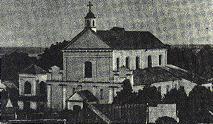 Therefore it was this area - now part of Belarus', and at the time called
Chornaja Rus'
(Black Rus') with its capital Novaharodak - that became the cradle of the Grand Duchy of
Litva, a new and powerful state in Eastern Europe (see also The origins of the Grand Duchy of Litva).
Therefore it was this area - now part of Belarus', and at the time called
Chornaja Rus'
(Black Rus') with its capital Novaharodak - that became the cradle of the Grand Duchy of
Litva, a new and powerful state in Eastern Europe (see also The origins of the Grand Duchy of Litva).
As soon as Novaharodak had managed to gain its independence from the princes of
Galic-Valyn, it strove to expand its power to other Belarusan territories. However, one of
the main obstacles on this way was Litva, an island of Baltic population amongst Slavic
tribes. The first challenge and test for Novaharodak was therefore to conquer Litva. In
order to achieve this aim, the nobles of Novaharodak invited Mindouh, who had been evicted
out of Litva, to be their prince. (At that time it was characteristic in Eastern Slavic
societies for the nobles to invite or elect their prince.) According to the chronicles,
Mindouh converted from heathenism to Orthodox christianity in 1246 to become prince of
Novaharodak. (Later, to make peace with the Order, he converted to Catholicism and was
granted the title of king by the Pope) In 1248-49 he successfully waged war against Litva
and gained control of the territory. After the conquest of Litva, the winner, the Slavic
principality of Novaharodak, adopted the name of the conquered Baltic territory and the
new state was called the Great Duchy of Litva (see also The
origins of the Grand Duchy of Litva). 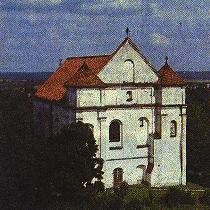 But this provoked another war between
Novaharodak and the princes of Galic-Valyn who also laid claim to a dominant position in
Eastern Europe. Novaharodak changed hands several times, until, in 1258, it was regained
by Mindouh's son Vojsalk (pronounced Voyshalk). Vojsalk, in contrast to his father, who
changed his faith depending on the political situation, was devoted to Orthodox
christianity and to the idea of uniting the territories around Novaharodak.
But this provoked another war between
Novaharodak and the princes of Galic-Valyn who also laid claim to a dominant position in
Eastern Europe. Novaharodak changed hands several times, until, in 1258, it was regained
by Mindouh's son Vojsalk (pronounced Voyshalk). Vojsalk, in contrast to his father, who
changed his faith depending on the political situation, was devoted to Orthodox
christianity and to the idea of uniting the territories around Novaharodak.
The next prince of Novaharodak, Trajdzien' (from 1270), was of Slavic stock. He expanded the principality to the West so that it comprised Horadzien (nowadays Hrodna) and the Padliassie region (nowadays Eastern Poland - the Bielastok region). Thus he aroused the anger of the princes of Galic-Valyn, who, with the help of a Tartar army, twice attacked and ravaged Novaharodak (in 1274 and 1277). From that time onwards Novaharodak gradually lost much of its power, as its strength was undermined by frequent conflicts and attacks from the South.
In 1315 the capital of the GDL was transferred to Vil'nia (nowadays Vilnius). In 1314 the famous Belarusan commander Davyd Haradzienski liberated the castle of Novaharodak from a siege by the knights of the Order.
But although Novaharodak was no longer the capital, it still played an important role
in the GDL. During the reign of Great Duke Vitaut the city enjoyed particularly high
esteem. It was the scene of several important state events; in 1415, for example, a
mitropolitan see for the whole country was created there. And it was also in Novaharodak
that King Jahajla married Sofija, the daughter of the prince of Gol'sany and Viaz'ma in
1432. In 1448 the city was the venue where the "sejm" (session of the
parliament) was held in the presence of King Kazimir. 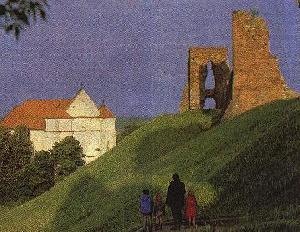
In 1511 the city was granted the Magdeburg Code of Law. From 1581 to 1775 the tribunal of the GDL met in Novaharodak every other year.
The city suffered heavily at the time of the war with Muscovite Russia in 1654-1667. In 1751 the biggest part of the city was destroyed by a fire. It can be said that from then on Navahradak started losing its significance and was gradually reduced to the status of a small town. In 1795, after the division of the Rec Paspalitaja, the town became part of Russia.
The old Navahradak had two castles: the residence of the Grand Dukes on the so-called
castle mound ("Dziadzinec") and the Maly Zamak (small castle). Both castles
existed from the 10th - 17th century. In 1706 the castle were blown up by the Swedes. The
Dziadzinec castle had seven towers and was one of the strongest fortifications in Belarus.
The original site of the castles was surrounded by earthen walls, the first of which was
539 m in diameter, the second 382 m. The walls overlooked the surroundings up to about 70
km (the castle hill is the highest point in the surroundings). Opposite the castle hill is
an artificial hill, which is popularly called Mindouh's hill. 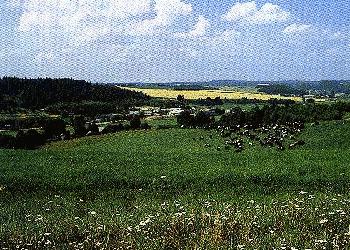
The oldest cathedral in Navahradak was founded in the 11th century. In the 17th century there were already 10 Orthodox churches and a Jesuit College, a Dominican and Franciscan monastery. The Calvinists also had their own churches.
In the surroundings of Navahradak an important part of the population was of Crimean Tartar stock. Their ancestors had been invited by the Grand Duke Vitaut in the 15th/16th century and settled there. Their descendants soon adopted the Belarusan language but continued to use the Arabic alphabet. Thus they have provided us with invaluable works of Belarusan literature - Muslim books written in old Belarusan with Arabic letters.
Navahradak was also the place where Adam Mickievic, a famous representative of Polish poetry of Belarusan stock, spent his youth.
Today one of the monuments which are left in Navahradak, apart from the castle ruins, is the Farny Catholic church, a baroque building. The first church on the spot was founded in 1395 during the reign of Prince Vitaut. in 1723 a new stone-built church was built which is still in service today. The Nalibockaja Pusca, an ancient woodland, and the Sviciaz' lake, one of the most beautiful lakes in Belarus', are not far from Navahradak. All these landscapes have been described in numerous works of poetry and are regarded as one of Belarus's most precious areas.
Links:
This page is part of the Virtual Guide to Belarus - a collaborative project of Belarusian scientists abroad Go to Belarusian towns, cities and several villages - Go to Belarusian Heritage main page © 1995-2004 VG |
 |